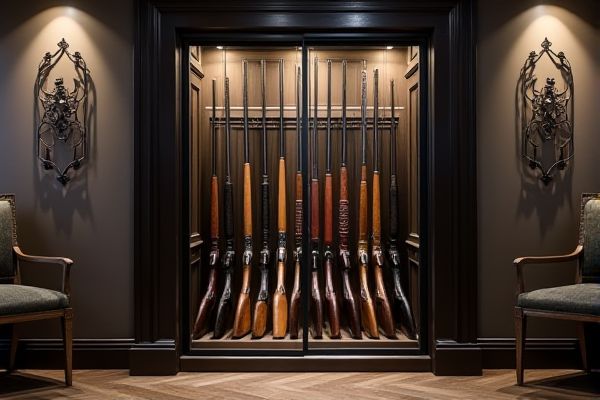
A gun safe is specifically designed to securely store firearms, featuring reinforced steel construction, specialized locking mechanisms, and interior compartments tailored to protect guns from theft and unauthorized access. Comparing a gun safe to a tool safe helps you choose the right storage solution based on security needs and content protection, so read on to discover which option best fits your requirements.
Table of Comparison
| Feature | Gun Safe | Tool Safe |
|---|---|---|
| Primary Purpose | Secure firearms and ammunition | Store and protect tools |
| Security Level | High - specifically designed to prevent unauthorized gun access | Moderate - focused on theft deterrence for tools |
| Build Material | Thick steel with reinforced locking mechanisms | Steel or heavy-duty metal, sometimes lighter than gun safes |
| Lock Types | Electronic keypad, biometric, or combination locks | Mechanical locks, padlocks, or key locks |
| Fire Resistance | Often fire-rated to protect firearms and documents | Less common, varies by model |
| Size & Interior | Designed to safely store rifles, pistols, and ammo boxes | Organized shelving and compartments for various tools |
| Price Range | Generally higher due to security features | Usually more affordable and varied |
Understanding the Purpose: Gun Safe vs Tool Safe
A gun safe is specifically designed to securely store firearms, providing protection against unauthorized access and environmental damage, while a tool safe focuses on organizing and safeguarding tools from theft and wear. You need to consider factors such as locking mechanisms, interior compartments, and fire resistance based on whether you are securing guns or tools. Prioritizing the intended purpose ensures optimal security and preservation for your valuable items.
Key Features of Gun Safes
Gun safes prioritize enhanced security features such as thick steel construction, advanced locking mechanisms, and reinforced doors to protect firearms from theft and unauthorized access. They often include interior compartments and customizable foam inserts designed to safely store and organize guns and ammunition. Your gun safe also typically provides fire and water resistance, ensuring the protection of your firearms under extreme conditions.
Essential Qualities of Tool Safes
Tool safes are engineered to provide superior durability and secure storage for high-value tools, featuring reinforced steel construction and advanced locking mechanisms resistant to tampering. These safes often include customizable compartments and foam inserts to protect tools from damage and ensure organized access. Your choice of a tool safe should prioritize impact resistance, fire protection, and convenient accessibility to safeguard valuable equipment effectively.
Security Standards: Comparing Protection Levels
Gun safes typically meet higher security standards such as UL-rated burglary and fire resistance, offering robust protection against theft and damage. Tool safes generally have lower security ratings, designed mainly to prevent unauthorized access rather than withstand forced entry or intense fires. Your choice should consider the level of threat protection required, with gun safes providing superior defense for valuable firearms and sensitive items.
Locking Mechanisms: Digital, Biometric, and Mechanical
Gun safes and tool safes both offer various locking mechanisms to secure their contents, including digital, biometric, and mechanical options. Digital locks provide quick access with programmable codes, while biometric locks enhance security through fingerprint recognition, making unauthorized entry more difficult. Mechanical locks offer reliability without batteries or electronics, ideal for scenarios where durability and simplicity are priorities for Your security needs.
Storage Capacity and Organization
Gun safes offer specialized storage with adjustable shelves and padded compartments designed to securely hold firearms, ammunition, and related accessories in an organized manner. Tool safes provide varied compartmentalization and heavy-duty drawers tailored to accommodate a wide range of hand tools, power tools, and hardware with enhanced accessibility for efficient workflow. Both safes maximize storage capacity while optimizing organization to protect valuable equipment and maintain orderly inventory management.
Fire and Water Resistance: What Matters Most
Gun safes and tool safes differ significantly in fire and water resistance, with gun safes typically designed to withstand higher temperatures and prolonged exposure to protect valuable firearms. Fire ratings for gun safes often exceed 1200degF for at least 60 minutes, while many tool safes offer lower ratings due to their intended purpose. Your choice should depend on the level of protection needed for your items, prioritizing fire and water resistance where firearm preservation is critical.
Legal and Regulatory Considerations
Gun safes must comply with specific federal and state regulations such as the Gun Control Act and California's Unsafe Handgun Act, ensuring secure storage to prevent unauthorized access. Tool safes generally have fewer regulatory requirements, focusing mainly on theft prevention rather than strict legal mandates. Compliance with laws impacts safe design features, lock types, and certification standards, making legal considerations crucial for gun safe buyers.
Installation and Accessibility
Gun safes often require heavy-duty installation, such as bolting to concrete floors or walls, to prevent theft and ensure durability, while tool safes typically have lighter installation demands and may not need anchoring. Accessibility in gun safes prioritizes quick entry methods like biometric locks or electronic keypads to ensure rapid access during emergencies, whereas tool safes focus on broader access for frequent use with standard key or combination locks. The balance between secure installation and ease of access varies significantly, depending on the safe's primary purpose and security requirements.
Cost Comparison: Value for Your Investment
Gun safes typically range from $300 to $2,000 depending on size, fire protection, and security features, while tool safes generally start lower at around $100 to $800. Investing in a gun safe offers enhanced protection against theft and fire, often including biometric locks and reinforced steel, which provide better long-term value for firearm security. Tool safes, although more affordable, may lack the specialized security features necessary to protect high-value firearms but are sufficient for organizing and securing general tools.
 homyna.com
homyna.com